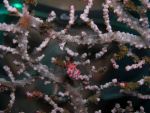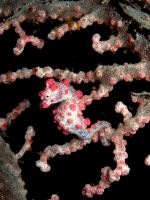Articles
Pygmy sea horses
2-12-2010
In this corner of the Pacific Ocean you will found a rich number of sea horses and pipefishes species. You can observe large and distinctive colored sea horses, but also those who are just few mm long. The smallest sea horses are called Pygmy. The best known species is Hippocampus bargibanti living in symbiosis with corals of the genus Muricella. Horses blend perfectly with their environment, not only they have the exact same color as the coral, but also their body have shape which resemble exactly the branchces of coral. On one speciment of such gorgonia we can count up to ten pygmy sea horses, but due to their small size it is very difficult to find them. Usually they grow as the average size of a human pinky fingernail up to maximum 2.5 cm.
There are still new reports all around the world that new unique species of pygmy sea horse are being discover. It is not surprising that these tiny creatures escaped our attention for a long time. The first pygmy sea horse was discovered during the examination of gorgonian branch in the laboratory in 1970. The original name pygmy was firstly intended only for the species Hippocampus bargibanti, but from 1997 when the discoveries of new species began the name pygmy was therefore used for all these tiny sea horses living in symbiosis with gorgonians (Muricella, Annella, Acanthogorgia), colonial anthozoans (Lytocarpus, Antennellopsis ) or even with seaweed of genus Halimeda.
The most recent study was conducted from December 2008 to January 2009 and brought first new discoveries after five years. They have described 5 new species of pygmy sea horses from the Red Sea and Indonesia. So this group of small unique little creatures increased to the current number of nine species: Hippocampus bargibanti, Hippocampus colemani, Hippocampus debelius, Hippocampus denise, Hippocampus minotaur, Hippocampus pontohi, Hippocampus satomiae, Hippocampus severnsi a Hippocampus waleananus. All Pygmy sea horses are very different from other big species of the genus Hippocampus. They have a small bar on the base of their tail, they also have a smaller number of rings forming the tail. As far as reproduction it is the same as for the larger species where the male cares for eggs in a pouch on his belly, but the hole to it is reversed, which is probably an adaptation to small body size. They have a very small number of youngs, mostly less than a dozen. The spawn immediately after birth spent some time as a larva floating in the plankton before settling down.
Molecular study of 32 sea horses species of genus Hippocampus showed that H. bargibanti is distant from other larger species and it has a separate branch in phylogenesis. It is therefore possible that in the near future, a group of pygmy sea horses will systematically apart from the larger species. All Pygmy sea horses belong to the IUCN Red List with status data deficient and they are also included in the CITES list. In terms of protection and understanding these unique species the research is essential, but the small size and perfect camouflage makes it absolutely impossible to find them and explore in the wild.
Along with the pygmy seahorses appeared in 2007, a new group of fish called the pygmy dragon pipefish. These animals are very unique and extremely small. Near the coast of North Sulawesi and other areas of Indonesia they are now being discovered a lot. The small pipefish is called Kyonemichthys rumengani and iit s expected to be much more widespread than it is now seemed. In upcoming years we can certainly wait for new discoveries.
back





